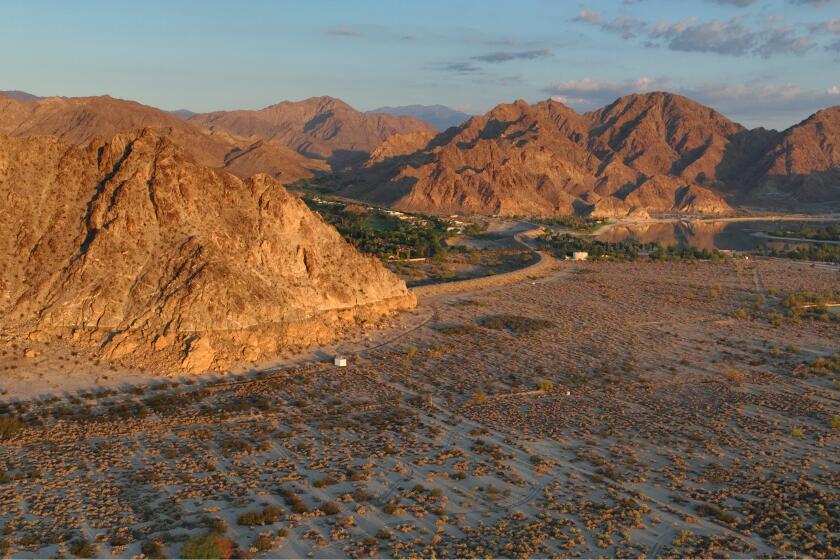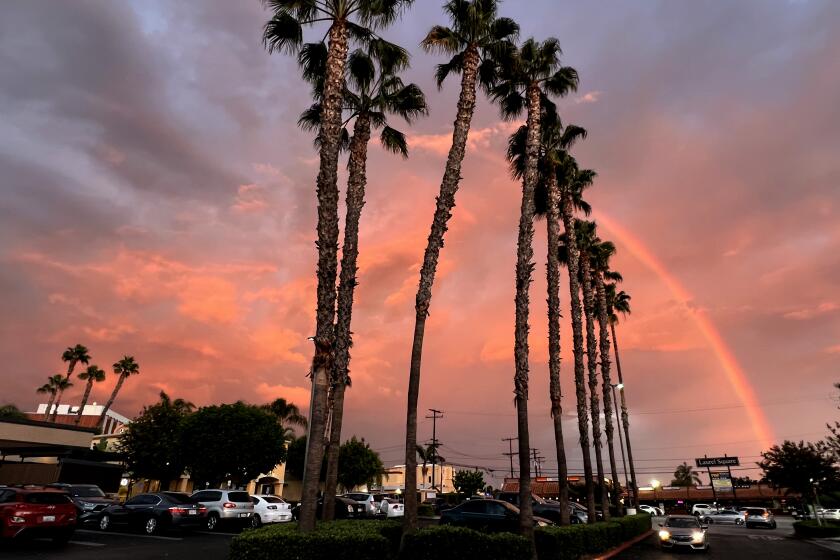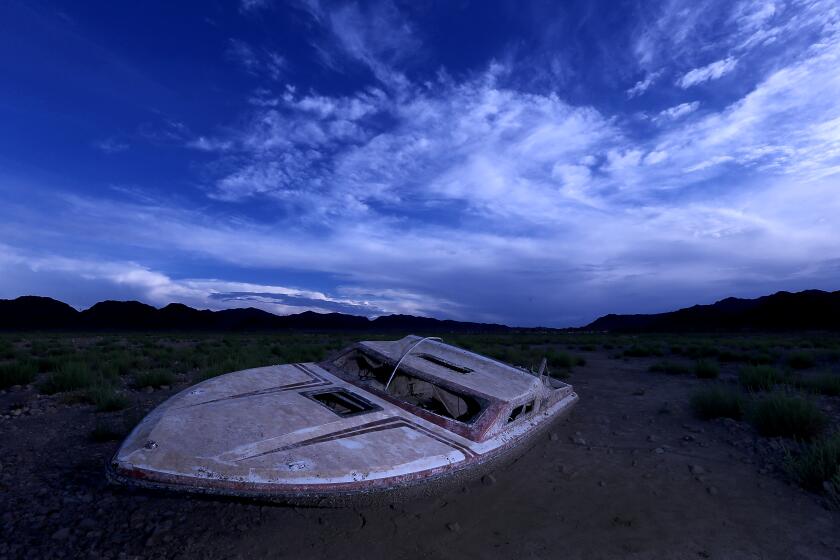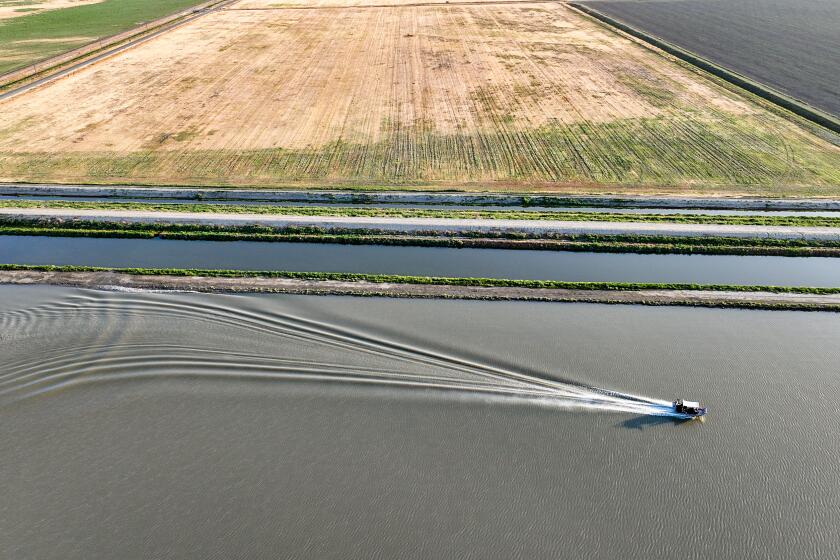Proposed surf park in California desert is rejected by La Quinta City Council
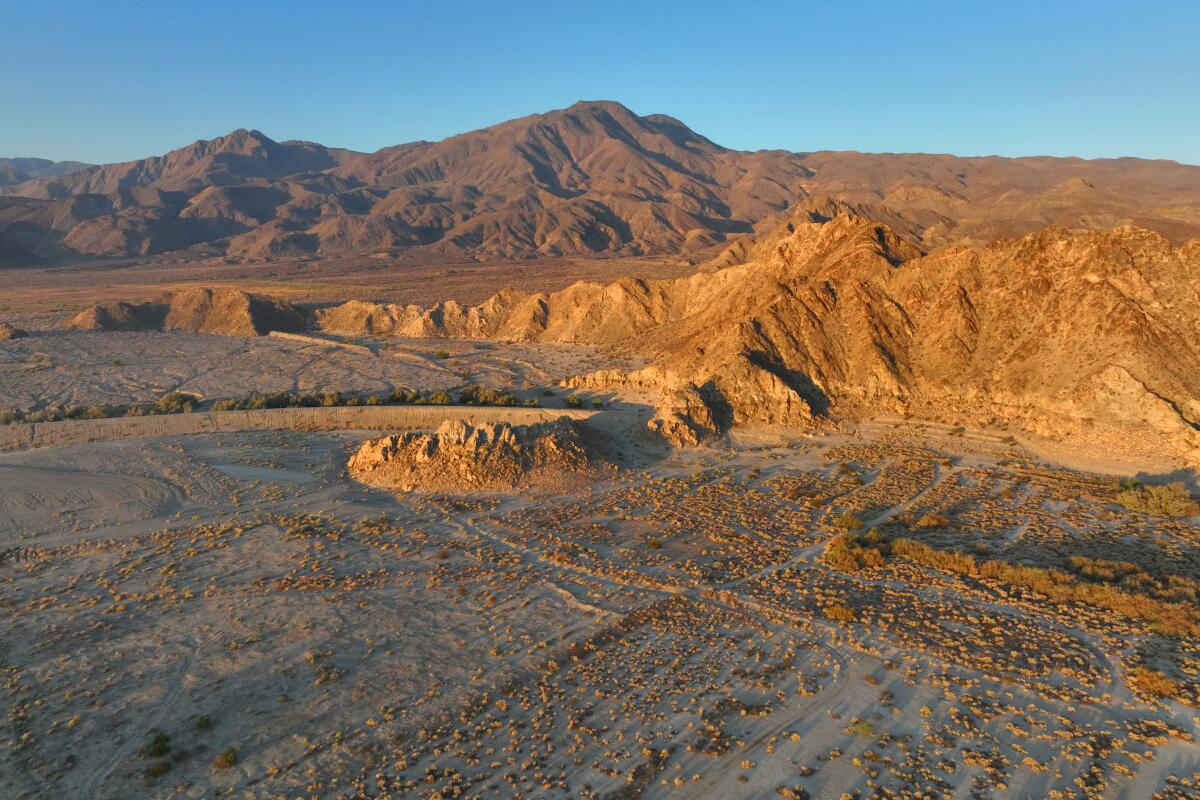
A developer’s proposal to build a surfing lagoon in the Coachella Valley desert has been rejected by the city of La Quinta after residents raised concerns about noise, lighting and the resort’s substantial water footprint in a time of severe drought.
The City Council’s five members voted unanimously Wednesday night against a zoning change that would have allowed the developer to build the resort and surf park.
Mayor Linda Evans said she loves the surf park concept and would like to see one built elsewhere in La Quinta eventually.
“I think this is a cool project,” Evans said. “But I don’t think it’s in the right location. And maybe the timing isn’t great because of the drought.”
A developer plans to build a large surfing pool in La Quinta. Critics argue it would require too much water as California grapples with drought.
The developer of the 386-acre Coral Mountain project in Riverside County had requested a zoning change for what was once slated to be a residential development with a golf course. Instead, the proposal was for the wave park, along with 600 homes and a hotel with up to 150 rooms.
The wave basin would have stretched across 16.6 acres and required 18 million gallons to fill.
During a meeting that lasted more than six hours, opponents said the surf park would pollute a quiet neighborhood with noise and light, and waste precious water at a time when California and the Southwest are enduring a megadrought exacerbated by climate change.
“We’re at a point in history where we cannot be freely wasteful of water,” said Laura Dolata, a resident. “When the water crisis reaches a critical point and water must be curtailed dramatically, and rationing becomes a reality, an operating wave park will be a problem for all of us.”
Dolata and others pointed out that residents have been told to conserve water at home, or face penalties on their water bills if they exceed their outdoor water budget. With the Colorado River in a shortage and the Southwest getting hotter and drier with climate change, opponents argued that cities in the Coachella Valley shouldn’t be signing off on water-intensive developments.
The uproar parallels a larger debate over how the Coachella Valley — with its 120 golf courses, artificial lakes and developments filled with thirsty grass — should adapt to worsening water scarcity.
More dryness, extreme weather events and water quality hazards are likely in 2023, state water officials said Wednesday.
At least four other new wave pools or lagoons are expected to be built in the valley. The plans drew scorn recently from “Last Week Tonight” comedian John Oliver, who declared that it’s “just monumentally stupid.”
The developers and their supporters said the resort would boost La Quinta’s economy with a world-class wave pool. The developers offered to contribute money for lawn-removal rebates in the city, which they argued would more than make up for the water needed to fill the wave basin.
“I’m so excited about this project. I think it’s unique,” said Connie Varelli, who owns property nearby. “It’s going to enliven and enhance our community.”
The wave basin was to be the second in the country to use technology from Kelly Slater Wave Co., producing waves up to 6 feet high. The technology debuted in 2015 at a surf ranch in the Central Valley, where Slater generated a sensation when he showed video of himself surfing flawless barreling waves miles from the ocean.
Some of the project’s supporters said they traveled to surf the wave in Lemoore and were hooked. They said they hoped to be able to catch similar waves in the desert.
“It’s just a beautiful wave that you can surf for a long minute, and for people like me who have young kids, young families, I think this is going to be a great attraction,” said resident Danilo Kawasaki.
Others said they would move to La Quinta to buy a home at the resort. The property is located at the base of Coral Mountain, which towers above the desert floor.
Chuy Reyna, a former professional surfer, said the wave pool in Lemoore is like “Pebble Beach for golfers,” and would help put La Quinta on the map as a surf destination.
Some supporters wore T-shirts reading “ON BOARD.”
Though the recent rains have helped tame some active blazes, it’s too soon to say goodbye to this year’s fire season.
They argued the noise would be minimal, and touted the tax revenues the resort would bring. They noted that the Coachella Valley Water District already endorsed the development’s total water use, which would amount to more than 900 acre-feet a year.
The valley’s cities, farms and golf courses rely on both groundwater and Colorado River water.
“I know the rest of California is in a major drought. But we here have an abundance of water,” said Paula Turner, a resident who said she hoped to build a home next to the surf park.
John Gamlin, president of CM Wave Development LLC said the wave basin’s annual use was estimated at 26 million gallons, much less than a golf course, which in the desert can use as much as 1 million gallons a day.
However, opponents disputed the developer’s estimate of how much water would evaporate from the pool, arguing that with crashing waves and heat, evaporation would require significantly more refilling.
Karen Tomcala, a La Quinta resident, urged the City Council to reject the zoning change, saying they should instead approve another sort of development that would “bring revenue to the city without draining the precious water resources on which our very existence depends.”
“You are the leaders that determine what La Quinta stands for,” Tomcala said, “and how we stand in the community in a time of climate change that is truly frightening.”
As reservoirs decline on the Colorado River, California water agencies are under pressure to shoulder a substantial part of the inevitable cuts.
The Colorado River’s flow has shrunk dramatically during a 23-year megadrought that research shows is being worsened by global heating. Southern California water districts are under pressure to shoulder substantial reductions as the federal government pushes for solutions to prevent the river’s largest reservoirs, Lake Mead and Lake Powell, from dropping to dangerously low levels.
Jay Famiglietti, a water scientist who leads the Global Institute of Water Security at the University of Saskatchewan, sent a letter to the City Council underlining the severity of the situation.
“My research has shown, simply put, that California and the southwestern U.S. are running out of water,” Famiglietti said in the letter, which was read during the meeting. “The Colorado River basin is drying up, Lakes Powell and Mead are at unprecedented low levels, and cuts to surface water allocations are actively being negotiated.”
Famiglietti said that depletion of groundwater in the region is far outstripping the water losses in Lake Mead and Lake Powell. He said the region’s water supplies are “rapidly declining due to climate change, overallocation, and the mismanagement of groundwater,” all of which “indicates that every drop counts, and stronger conservation efforts will be needed to secure La Quinta’s water future.”
James Vaughn, a lawyer for the developers, said the assessment by the Coachella Valley Water District shows there would be enough water for the project. Vaughn said the valley’s groundwater basin, which has been boosted by imported water, is in relatively better condition than the declining aquifers of the Central Valley.
“You can’t solve the Colorado River challenge by denying a good project,” Vaughn said. “The wave basin is going to invest $6 million in local water conservation. That makes it part of the solution.”
But several residents said the offer to help pay for lawn-removal rebates didn’t assuage their concerns about what they called a wasteful use of water.
“Water is the new gold,” Carel Adler said. “If there’s no water, there’s no entitlement.”
A war on urban coyotes is exposing deep divisions between those who want to eradicate the animal and those who are calling for peaceful coexistence.
Lisa Jeffrey expressed worry about traffic, noise and a party atmosphere, but also said: “We are in a megadrought, and it’s frightening how environmentally this could impact us.”
Guillermo Casillas, who owns a home next to property, said he’s not against building on the land, but he strongly opposes the wave pool. He pointed out that at nearby mobile home parks in the eastern Coachella Valley, including one where relatives live, the water is contaminated with toxic arsenic and unsafe to drink.
“We just don’t have the water to spare for this particular project,” Casillas said. “I am 100% against it, because we just can’t waste that water. … We need water to drink, not to surf on.”
Before voting, City Council members explained their reasons for rejecting the zoning change.
Council member Steve Sanchez said he wasn’t at all concerned about water, but he was concerned about the effect of a zoning change for those who have owned homes in the area for years.
“It’s a big concern of mine that the people who live in that community never expected a wave park to be built,” Sanchez said.
Council member John Peña agreed. “We have never really anticipated having 600 short-term rentals out in an area that is basically residential.”
Following the vote, Garrett Simon of Meriwether Cos., a partner in the project with CM Wave Development, LLC, said in an email that they plan to “evaluate our options.”
Meanwhile, other large water features are expected to be built elsewhere in the Coachella Valley.
A development with a 20-acre surf lagoon, Thermal Beach Club, has already been approved by Riverside County supervisors. In Rancho Mirage, construction has begun at Disney’s Cotino development, which will include a 24-acre lagoon, this one without waves. And two other wave pools are in the works in Palm Desert and Palm Springs.
More to Read
Start your day right
Sign up for Essential California for news, features and recommendations from the L.A. Times and beyond in your inbox six days a week.
You may occasionally receive promotional content from the Los Angeles Times.
